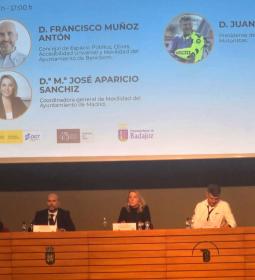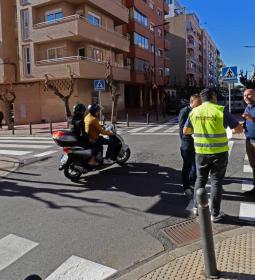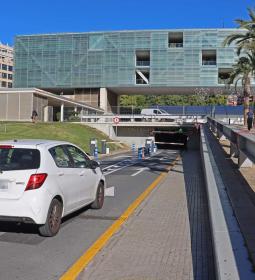These vehicles are prohibited from driving on sidewalks and pedestrian streets
The ordinance that requires users of electric scooters to wear a helmet and have civil liability insurance enters into force

<p>Sales and rental companies must identify and register all their personal mobility vehicles and cycles before the City Council, which will grant a QR code to each vehicle</p>
The modification of the Mobility ordinance regulating the use and circulation of electric scooters and other personal mobility vehicles in Benidorm has already entered into force, after the publication of the Official Gazette of the Province (BOP) yesterday. The Councilor for Mobility, José Ramón González de Zárate, recalled that this municipal regulation requires “users of electric scooters to go with a helmet and have a civil liability insurance”, and prevents these vehicles from circulating “on sidewalks and streets pedestrian ”.
The head of Mobility has pointed out that “although this regulation comes later than we would have wanted - it was blocked up to seven times in full by the opposition last legislature -, we are one of the first cities to regulate the circulation of electric scooters and we are serving as a model for other municipalities that ask us to send them our regulations to implement it ”.
De Zárate has informed that, in addition to the obligation to have a civil liability insurance, “in general all types of personal mobility vehicles must carry mandatory reflectors, lights and approved stamps”.
With regard to the areas of action, "no electric scooter or personal mobility vehicle may circulate on exclusively pedestrian streets, or on sidewalks or on bike lanes located therein." Yes you can do it, however, by the bike lanes located on the road. Also along the road they can circulate in the streets of ‘Zone 20’ and ‘Zone 30’ - streets such as Primavera or Estocolmo - respecting the speeds of these roads, as well as in the streets of mixed single platform such as Paseo de Levante. With regard to parks, the presence of personal mobility vehicles that circulate at pedestrian speeds and those for loading and unloading of goods is allowed.
The modification of the ordinance carries with it a table of sanctions, which oscillate “between 80 and 500 euros of fine depending on the infraction”. De Zárate has asked citizens “time to apply this ordinance in its entirety”, since it is necessary to give a “short but prudential period” for private users to know the new regulations, although it has advanced that “we are going to be drastic with companies when it comes to demanding that they comply. ”
The regulations also include a specific section for companies that rent this type of vehicles, which “must proceed to the registration and identification of them by telematic means and send them to the City Council”. Specifically, starting next week these merchants must complete this procedure through the Municipal Electronic Office (https://www.sede.benidorm.org), filling in the relevant form to which they must attach the certificate of technical characteristics and approval of each vehicle or cycle and provide civil liability insurance for all of them. Subsequently, the City Council will grant a QR identification code that “will allow the Local Police to have access to all the data and documentation of the vehicle”.
Types of personal mobility vehicles
Personal mobility vehicles are divided into five types:
1. Type A: Smaller and lighter wheels, platforms and electric scooters.
2. Type B: Large electric platforms and scooters.
3. Type C0: For personal use, similar to a bicycle, so that the traffic conditions and regulations will be the same as that of the bicycle.
4. Type C1: Destined for an economic exploitation activity.
5. Type C2: For the transport of goods.
Areas of circulation
1. Sidewalk circulation: VMP circulation is not allowed.
2. Street with a single platform: If the area is exclusively for pedestrians, VMP circulation is not allowed. If the movement of vehicles is allowed on the single platform, VMPs may drive at a maximum limited speed of 20 km / h, observing the priority of the pedestrian and adapting the speed to the circumstances of the road, even stopping the march.
3. Bicycle lane on the sidewalk: VMP circulation is not allowed.
4. Bike lane on the road: The circulation of typologies A, B, C0, C1 and C2 is allowed on these lanes, provided that the width of the cycling infrastructure allows it. It can only be circulated in the direction indicated in the lane, at a maximum of 20 km / h and respecting the road signs. In no case is the cycle-street cycle path considered.
5. Road zone 20: The circulation of typologies A, B, C0, C1 and C2 is allowed through this type of lane, at a maximum of 20 km / h in the indicated direction of movement.
6. Roadway: The circulation of vehicles of type C0, C1 and C2 is allowed on all roads limited to 30Km / h.
7. Parks: Only type A and B vehicles are allowed at pedestrian speed (maximum 4 kilometers per hour). Type C2, urban merchandise distribution, can circulate through them, at pedestrian speed and only to access the establishments for loading and unloading. The preference of pedestrians, natural heritage and urban furniture must be respected. The signage must be respected, and the cycling routes and itineraries of the paved or dirt areas should be used, if any. It is not possible to circulate on flowerbeds, areas or zones with vegetation of any type, nor for all those zones marked with express prohibition.




